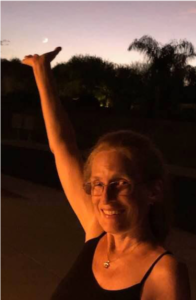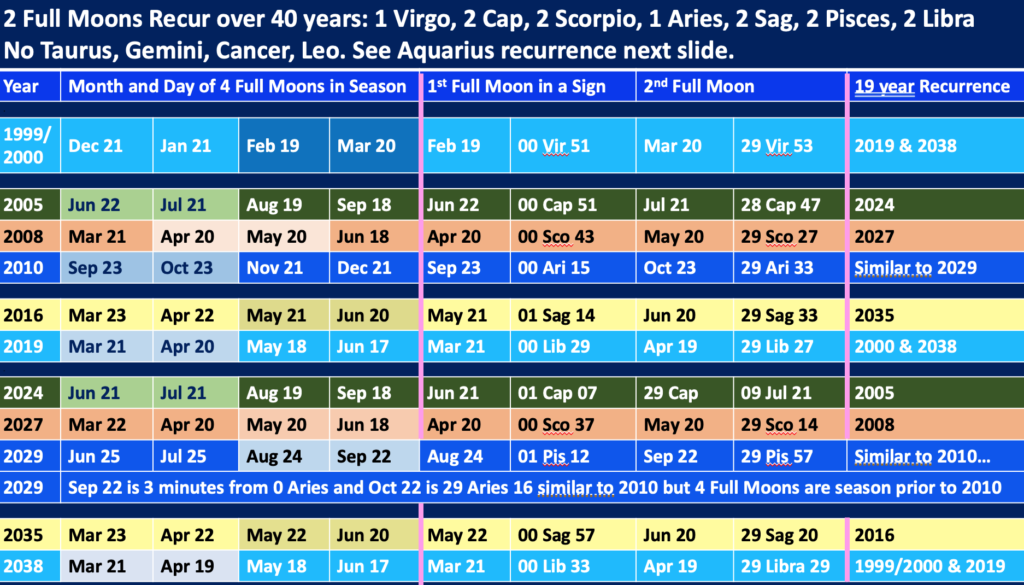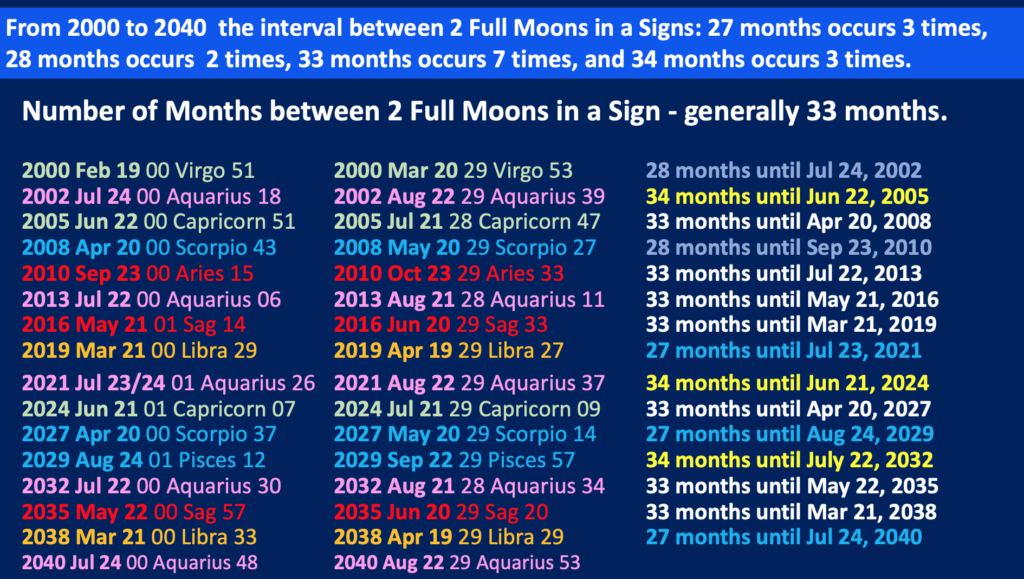When is the Real Blue Moon?
In 2022 there are no derivations of the Blue Moon as described below and only 12 Full Moons in that calendar year. In 2023 there are 13 Full Moons in the Calendar year from January 1 to Dec 31 and two Full Moons in the calendar month of August.
In 2024 we have two Full Moons in Capricorn on June 21 and July 21 and two more Full Moons in that season on Augsut 19 and September 17 meaning there are 4 Full Moons in a season. This is the original definition of a Blue Moon as described below, but there are only 12 Full Moons in that calendar year. However, from the December Solstice of 2023 to December Solstice of 2024 their are 13 Full Moons.
Understanding the Blue Moon
The idea or concept that two Full Moons in a month is what defines a Blue Moon is a mistake, according to this article from the Smithsonian that was published in 2012/
The article tells us the original definition of a Blue Moon referred to 4 Full Moons in one season and a season is defined as the time between a Solstice and Equinox or an Equinox and Solstice. (See Table below)
From the perspective of Solstices and Equinoxes, there are four seasons in a year and generally three Full Moons occur in each season. This means there are usually 12 Full Moons per year.
This is why the word month comes from the word Moon or Moonth, because it take 29.5 days for the Moon to return to another Full Moon phase (or any Moon phase for that matter).
This suggests that our secular calendar actually does recognize that they are at least 12 Full Moons each year. Looking at this from the perspective of the Gregorian Calendar that was instituted in 1582 the years that have two Full Moons in a month are the years that also have 13 Full Moons in a calendar year.

There are four types of Blue Moons discussed below:
Calendric, Seasonal, Astrological and Environmental
In more recent times, the term Blue Moon has been used to describe the occurrence of two Full Moons in a calendar month. This way of defining a Blue Moon comes from a 1940’s article that appeared in Astronomy magazine suggesting the definition of a Blue Moon was the second Full Moon in a calendar month, an event that occurs approximately every 33 months.
Interestingly, two Full Moons in a month, or two Full Moons in the same sign and four Full Moons in a season, occur with the same frequency. (See the tables below) However, two Full Moons in the same sign and four Full Moons in a season has greater astronomical significance than two Full Moons in a calendar month.
This is because the months as outlined in our Gregorian Calendar are NOT astronomically based but rather begin arbitrarily on a date called January 1 so our calendar begins at a time that is not connected to either a Solstice or Equinox. It is also not connected to the lunar cycle.
The Gregorian calendar does, however, track time through days, weeks, months and years. These dates have been assigned names and numbers and it works brilliantly as a linear way of tracking time while down playing a more cyclical way of tracking time through the seasons having the affect of fixating our awarness on a more linear experience of time.
The Blue Moon seen through Smoke
There is another speculation that the original term Blue Moon may have come from the bluish tinge the Moon gets when viewed through smoke. In this case, the theory is – someone saw the Moon appearing very blue through the smoke of a large distant fire (forest fire?) and therefore the term Blue Moon was a literal description of how the Moon looked. Naturally this would most likely be the most rare occurrence and an actual Blue Moon as in the Moon appears to be Blue.
Here is a 2012 YouTube from Nasa on Blue Moons with the cultural definition and also why the Moon is Red and sometimes Blue when volcanos and fires are involved. http://www.youtube.com/watch?v=4HRKl0fa2dg
Two Consecutive Full Moons in the Same Sign Usually Happens when there are Four Full Moons in a Season
There is another way the Full Moon (or any phase of the Moon for that matter) fits the approximately 33 month pattern. This configuration isn’t talked about as much but is just as significant as the other patterns, and that is when there are two consecutive Full Moons in the same sign. This only occurs when the first Full Moon is in Zero or One degree of the sign and the next Full Moon is in 28 or 29 degrees of the same sign.
As already mentioned above, July 22, 2021 was a Full Moon in early degrees of Aquarius. The following month on Aug 21 there was another Full Moon in late degrees of Aquarius. This exact configuration happens again in Jul and August of 2040 with the Moon very close to the same degrees that occurred in 2021.
Note: This nearly exact recurrence is tracking the 19 year nodal cycle. (A topic for another article)
Blue Moon Mystique
The common factor to all these variations of a Blue Moon, either as seen through smoke, or the number of Full Moons in a season, or two Full Moons in a month, or two consecutive Full Moons in the same sign, is they captivate and inspire our imagination.
When we understand the pattern of what is happening then we can intentionally tune into the magic, getting the most out of the opportunity these Timings represent. One of the opportunities any Full Moon provides is a chance to experience greater illumination of our essential divine nature regardless of whether or not it is a so-called Blue Moon.
From the perspective that we inform the mysteries as much as they inform us, what we put our attention and intention on becomes meaningful. Since there is a lot of collective attention on the phenomenon of two Full Moons in a month, (even though its not astronomically significant) it has the effect of taking on greater significance as a result.
Noticing the Pattern
Below are tables of the various types of Blue Moon dates to ponder. These tables clearly show the pattern of about 33 months for all the above variations, except for the one that has to do with seeing the Moon through smoke.
One way to work with this information and the dates below is to notice if any of these Timings were especially significant in your personal experience. Also worth noticing is if there were significant events in the world that happened around any of the prior so-called Blue Moon times?
A Personal Realization
In tracking this personally, I had a profound experience with a group down in Peru during the December 2002 Full Moon – Blue Moon of four Full Moons in a season (see table below) that was beyond the beyond of anything I had experienced previously. (Here is a more mytho-poetic version of that time )
In July 2004, there were two consecutive Full Moons in a calendar month. At the time of the second Full Moon of July – during another Full Moon ceremony I was a part of – I had an illumination about a personal situation that had been especially challenging. This Timing also coincided with a powerful Pluto transit to my natal Moon, so the Full Moon activation was a part of that cycle and it turned out to be a further catalyst for an initiatory process I was already experiencing, meaning the two factors were working together to help support my journey and may not have had anything to do with the fact that it was the second Full Moon of the month.
Knowing your cycles and participating in Full Moon ceremonies can help further what ever initiation cycles are going on for you. I have noticed if the Full Moon activates a personal part of my own chart regardless of whether it is a so-called Blue Moon it is extra powerful for me.
The Full Moon Effect Lasts at least Three Days and 3 Nights
Experientially the Moon appears full for three nights, the day before, the day of and the day after the exact Full Moon. Shamanically speaking this suggests the potency of the Full Moon Window lasts for at least three days. Many cultures including the Hawaiians (Hawaiian Moon Calendar article) worked with every possible phase of the Moon in its 29.5 day cycle before it returns to a specific Moon phase and they considered the Moon to be in its full phase for 4 days and nights.
The Hawaiians use 29 and sometimes 30 phases of the Moon, giving each phase its own special name and indications like when it was a good time to fish, or to plant, or to get married, or to stay home.
Is 12 or 13 the Most Sacred Number of the Moon?
In recent years, there have been many articles and books claiming that the number 13 is the most sacred number for the Moon. However, the Moon actually intimately connects with the numbers 12, 13 and 19.
If you are tracking the Moon return to a certain zodiacal degree, say zero Capricorn, it will return to that degree every 27.3 days. If you divide 27.3 into 365 days in a year – the closest whole number is 13. That means the Moon will cross that point or any other starting point 13 times each year.
If you are tracking the Moon phases from Full Moon to Full Moon or any other phase (i.e. New Moon to New Moon or First Quarter Moon to First Quarter Moon) it returns every 29.5 days. If you divide 29.5 into 365 the closest whole number is 12. That is why there are 12 months (moonths) in a year.
It is important to realize the number 13 for the Moon is NOT what most people think it is. There are NOT 13 Full Moons every year regardless of whether you are tracking a calendar year, or a seasonal year – from one December Solstice to the next. Actually more often than not there are only 12 Full Moons a year. That is why both 12 and 13 are sacred numbers, or sacred patterns for the Moon.
Additionally, the 19 year pattern or cycle of the Moon is significant to our personal experience especially when we are turning 19, 38, 57, 76, and 95. This 19 year Moon cycle is related to the Nodes of the Moon and the Eclipses. The point here is that there is more than one sacred number for the Moon, as the Moon has many patterns that are worth knowing and understanding, because these patterns do play out in our personal and collective experience.
The Tables Below show the patterns of the Full Moon occurring about every 33 months no matter what pattern you are tracking.
4 Full Moons in a Season and 2 Full Moons in the same sign. 2010 and 2038 also feature an eclipse season. The colors match up to the 19 year repeating pattern of the Moon


Two Full Moons in Sign

Two Full Moons in a Calendar Month

The Number of Full Moons in a Calendar Year from 2022 to 2030.
12 Full Moons in 2022 Calendar Year
Jan 17 2022 Full Moon 3:48:16 PM PST 27°Cn51′ D
Feb 16 2022 Full Moon 8:56:21 AM PST 28°Le00′ D
Mar 18 2022 Full Moon 12:17:24 AM PDT 27°Vi40′ D
Apr 16 2022 Full Moon 11:54:52 AM PDT 26°Li46′ D
May 15 2022 Full Moon 9:13:58 PM PDT 25°Sc18′ D
Jun 14 2022 Full Moon 4:51:35 AM PDT 23°Sg25′ D
Jul 13 2022 Full Moon 11:37:27 AM PDT 21°Cp21′ D
Aug 11 2022 Full Moon 6:35:34 PM PDT 19°Aq21′ D
Sep 10 2022 Full Moon 2:58:52 AM PDT 17°Pi41′ D
Oct 9 2022 Full Moon 1:54:47 PM PDT 16°Ar33′ D
Nov 8 2022 Full Moon 3:01:57 AM PST 16°Ta01′ D
Dec 7 2022 Full Moon 8:07:59 PM PST 16°Ge02′ D
13 Full Moons in 2023 Calendar Year
Jan 6 2023 Full Moon 3:07:42 PM PST 16°Cn22′ D
Feb 5 2023 Full Moon 10:28:22 AM PST 16°Le41′ D
Mar 7 2023 Full Moon 4:40:09 AM PST 16°Vi40′ D
Apr 5 2023 Full Moon 9:34:19 PM PDT 16°Li07′ D
May 5 2023 Full Moon 10:33:51 AM PDT 14°Sc58′ D
Jun 3 2023 Full Moon 8:41:31 PM PDT 13°Sg18′ D
Jul 3 2023 Full Moon 4:38:29 AM PDT 11°Cp19′ D
Aug 1 2023 Full Moon 11:31:27 AM PDT 09°Aq16′ D August 2023 has 2 Full Moons in a month
Aug 30 2023 Full Moon 6:35:25 PM PDT 07°Pi25′ D
Sep 29 2023 Full Moon 2:57:19 AM PDT 06°Ar00′ D
Oct 28 2023 Full Moon 1:23:49 PM PDT 05°Ta09′ D
Nov 27 2023 Full Moon 1:16:05 AM PST 04°Ge51′ D
Dec 26 2023 Full Moon 4:32:59 PM PST 04°Cn58′ D
12 Full Moons in 2024 Calendar Year A True Blue Moon Year with 4 Full Moons in a season & two in the same sign
Jan 25 2024 Full Moon 9:53:47 AM PST 05°Le15′ D
Feb 24 2024 Full Moon 4:30:12 AM PST 05°Vi23′ D
Mar 25 2024 Full Moon 12:00:06 AM PDT 05°Li07′ D
Apr 23 2024 Full Moon 4:48:45 PM PDT 04°Sc18′ D
May 23 2024 Full Moon 6:52:54 AM PDT 02°Sg55′ D
Jun 21 2024 Full Moon 6:07:39 PM PDT 01°Cp07′ D 4 Full Moons in a Season
Jul 21 2024 Full Moon 3:16:55 AM PDT 29°Cp09′ D
Aug 19 2024 Full Moon 11:25:34 AM PDT 27°Aq15′ D
Sep 17 2024 Full Moon 7:34:13 PM PDT 25°Pi41′ D
Oct 17 2024 Full Moon 4:26:09 AM PDT 24°Ar35′ D
Nov 15 2024 Full Moon 1:28:16 PM PST 24°Ta01′ D
Dec 15 2024 Full Moon 1:01:26 AM PST 23°Ge53′ D
12 Full Moons in 2025 Calendar Year
Jan 13 2025 Full Moon 2:26:39 PM PST 24°Cn00′ D
Feb 12 2025 Full Moon 5:53:09 AM PST 24°Le06′ D
Mar 13 2025 Full Moon 11:54:24 PM PDT 23°Vi57′ D
Apr 12 2025 Full Moon 5:22:00 PM PDT 23°Li20′ D
May 12 2025 Full Moon 9:55:41 AM PDT 22°Sc13′ D
Jun 11 2025 Full Moon 12:43:35 AM PDT 20°Sg39′ D
Jul 10 2025 Full Moon 1:36:32 PM PDT 18°Cp50′ D
Aug 9 2025 Full Moon 12:54:48 AM PDT 17°Aq00′ D
Sep 7 2025 Full Moon 11:08:38 AM PDT 15°Pi23′ D
Oct 6 2025 Full Moon 8:47:21 PM PDT 14°Ar08′ D
Nov 5 2025 Full Moon 5:19:02 AM PST 13°Ta23′ D
Dec 4 2025 Full Moon 3:13:48 PM PST 13°Ge04′ D
13 Full Moons in 2026 Calendar Year – two Full Moons in the same month
Jan 3 2026 Full Moon 2:02:38 AM PST 13°Cn02′ D
Feb 1 2026 Full Moon 2:08:58 PM PST 13°Le04′ D
Mar 3 2026 Full Moon 3:37:37 AM PST 12°Vi54′ D
Apr 1 2026 Full Moon 7:11:41 PM PDT 12°Li21′ D
May 1 2026 Full Moon 10:22:53 AM PDT 11°Sc21′ D
May 31 2026 Full Moon 1:44:55 AM PDT 09°Sg56′ D
Jun 29 2026 Full Moon 4:56:24 PM PDT 08°Cp15′ D
Jul 29 2026 Full Moon 7:35:26 AM PDT 06°Aq30′ D
Aug 27 2026 Full Moon 9:18:14 PM PDT 04°Pi54′ D
Sep 26 2026 Full Moon 9:48:45 AM PDT 03°Ar37′ D
Oct 25 2026 Full Moon 9:11:31 PM PDT 02°Ta46′ D
Nov 24 2026 Full Moon 6:53:16 AM PST 02°Ge20′ D
Dec 23 2026 Full Moon 5:27:56 PM PST 02°Cn14′ D
12 Full Moons in 2027 Calendar Year A True Blue Moon Year with 4 Full Moons in a season & two in the same sign
Jan 22 2027 Full Moon 4:17:05 AM PST 02°Le14′ D
Feb 20 2027 Full Moon 3:23:21 PM PST 02°Vi06′ D
Mar 22 2027 Full Moon 3:43:29 AM PDT 01°Li35′ D
Apr 20 2027 Full Moon 3:26:51 PM PDT 00°Sc37′ D
May 20 2027 Full Moon 3:58:42 AM PDT 29°Sc14′ D
Jun 18 2027 Full Moon 5:44:02 PM PDT 27°Sg33′ D
Jul 18 2027 Full Moon 8:44:36 AM PDT 25°Cp49′ D
Aug 17 2027 Full Moon 12:28:22 AM PDT 24°Aq12′ D
Sep 15 2027 Full Moon 4:03:12 PM PDT 22°Pi53′ D
Oct 15 2027 Full Moon 6:46:41 AM PDT 21°Ar59′ D
Nov 13 2027 Full Moon 7:25:36 PM PST 21°Ta31′ D
Dec 13 2027 Full Moon 8:08:28 AM PST 21°Ge25′ D
13 Full Moons in 2028 Calendar Year
Jan 11 2028 Full Moon 8:02:45 PM PST 21°Cn28′ D
Feb 10 2028 Full Moon 7:03:26 AM PST 21°Le24′ D
Mar 10 2028 Full Moon 5:05:45 PM PST 20°Vi59′ D
Apr 9 2028 Full Moon 3:26:18 AM PDT 20°Li06′ D
May 8 2028 Full Moon 12:48:36 PM PDT 18°Sc44′ D
Jun 6 2028 Full Moon 11:08:29 PM PDT 17°Sg02′ D
Jul 6 2028 Full Moon 11:10:29 AM PDT 15°Cp11′ D
Aug 5 2028 Full Moon 1:09:29 AM PDT 13°Aq26′ D
Sep 3 2028 Full Moon 4:47:15 PM PDT 11°Pi59′ D
Oct 3 2028 Full Moon 9:24:39 AM PDT 10°Ar59′ D
Nov 2 2028 Full Moon 2:17:01 AM PDT 10°Ta29′ D
Dec 1 2028 Full Moon 5:39:53 PM PST 10°Ge24′ D
Dec 31 2028 Full Moon 8:48:10 AM PST 10°Cn33′ D
12 Full Moons in 2029 Calendar Year A True Blue Moon Year with 4 Full Moons in a season & two in the same sign
Jan 29 2029 Full Moon 10:03:16 PM PST 10°Le38′ D
Feb 28 2029 Full Moon 9:09:54 AM PST 10°Vi24′ D
Mar 29 2029 Full Moon 7:26:03 PM PDT 09°Li41′ D
Apr 28 2029 Full Moon 3:36:27 AM PDT 08°Sc26′ D
May 27 2029 Full Moon 11:37:09 AM PDT 06°Sg45′ D
Jun 25 2029 Full Moon 8:21:59 PM PDT 04°Cp50′ D
Jul 25 2029 Full Moon 6:35:24 AM PDT 02°Aq54′ D
Aug 23 2029 Full Moon 6:50:52 PM PDT 01°Pi12′ D
Sep 22 2029 Full Moon 9:28:57 AM PDT 29°Pi57′ D
Oct 22 2029 Full Moon 2:27:12 AM PDT 29°Ar16′ D
Nov 20 2029 Full Moon 8:02:36 PM PST 29°Ta08′ D
Dec 20 2029 Full Moon 2:46:08 PM PST 29°Ge21′ D
12 Full Moons in 2030 Calendar Year
Jan 19 2030 Full Moon 7:54:00 AM PST 29°Cn37′ D
Feb 17 2030 Full Moon 10:19:27 PM PST 29°Le38′ D
Mar 19 2030 Full Moon 10:56:07 AM PDT 29°Vi11′ D
Apr 17 2030 Full Moon 8:19:39 PM PDT 28°Li09′ D
May 17 2030 Full Moon 4:18:46 AM PDT 26°Sc37′ D
Jun 15 2030 Full Moon 11:40:38 AM PDT 24°Sg43′ D
Jul 14 2030 Full Moon 7:11:36 PM PDT 22°Cp41′ D
Aug 13 2030 Full Moon 3:44:01 AM PDT 20°Aq45′ D
Sep 11 2030 Full Moon 2:17:33 PM PDT 19°Pi11′ D
Oct 11 2030 Full Moon 3:46:28 AM PDT 18°Ar10′ D
Nov 9 2030 Full Moon 7:29:55 PM PST 17°Ta47′ D
Dec 9 2030 Full Moon 2:40:04 PM PST 17°Ge54′ D
I moved this article from the Shamanic Astrology Mystery School site so the comments posted below are from an earlier time. Please feel free to add your own comments in the comments section at the bottom of the page.
Hi Cayelin… great article!!! For what it is worth the Metatronic Councils of Light told me many years ago, circa 1997, that energetically they consider a “Blue Moon” to be defined by the circumstance you outline under your heading above “Two Consecutive Full Moons in the Same Sign”. Blissings, Simeon Chi’Ra
Janet Booth on
Hi, Cayelin – I enjoy your newsletters and was glad to see you explain the difference between the true origin of the term blue moon and the more common (erroneous) interpretation in use today. The research I did for the July episode of my LOOKING UP cable tv show mentioned the source of the word “blue” as likely having morphed from the Old English word “belewe” meaning to betray. Each of the full moons had a name and a place in its season.
When there was an extra full moon in winter, it affected the timing of Lent and Easter (which is defined as the first Sunday after the first full moon of spring). The “betrayer moon” (the third of the season) came too early to be the Lenten Moon and needed a different name or Christians would have to fast an extra month until Easter. (It’s easy to understand why no one wanted to do that!)
Thus, a blue moon does occur in a season with four full moons but it is NOT the fourth full moon, rather the third in the season. This method keeps the seasonal full moon names on track.
I also looked at the frequency of the two types of blue moons and found that because of time zone/international date line differences in our man-made calendars that the seasonal type of blue moons are actually a little more frequent than the two-in-a-calendar month variety.
The seasonal type occurs five times in a dozen years (using the 3rd of 4 in season definition):
Nov. 21, 2010 Aug. 20, 2013 May 21, 2016 May 18, 2019 Aug. 22, 2021
In the same period, the twice-in-a-month type occurs only once EVERYWHERE (and this month is it):
2009: Dec. 2 and 31 (except for parts of Asia, where the 2 full moons will be in Jan. 2010, on the 1st and 30th)
2010: (only in Asia) on March 1 and March 30 (elsewhere the full moon is on Feb. 28)
2012: (not in Asia) Aug. 2 and 31 (in the Far East, the second of these is on Sept. 1)
2012: (Far East) Sept. 1 and 30
2015: July 1-2 and 31 (EVERYWHERE)
2018: Jan. 2 and 31 (except in Asia, where the full moon will be Feb. 1)
2018: March 2 and 31 (except in the Far East and Pacific islands, where the full moon is April 1)
2020: Oct. 1 and 31 (except in the Far East, where the full moon is Nov. 10
So this month’s (though erroneous) blue moon is kind of a “once in a blue moon” phenomenon. Enjoy! Janet Booth
Wayne Minich, II on April 21, 2009 at 8:01 pm
There are two New Moons in Cancer in 2009. Cancer is ruled by the Moon, so it is a significant event. Although your article focuses on Full Moons, the opposite is true as well – there will be two New Moons in the same month or sign in between when there are two Full Moons in the same month or sign. These events are just as important, if not more than Full Moons.
During Full Moons, we have both classical planets, the Sun and the Moon, pulling on the Earth in opposite directions. However, during a New Moon phase those gravitational pulls are even greater when you have both the Moon and the Sun tugging on the Earth in the same direction.
Just something to add to your article… <> Wayne
Cayelin on May 30, 2009 at 5:42 pm
Thank you Wayne it is true this works for all the Moon phases New Moon, Full Moon and the First and Last Quarter Moons as well. Plus as you mentioned when the Moon is Perigee (or closest to the Earth) the New Moon and Full Moon will have a greater affect on the tides and the weather patterns as was evidenced in the summer of 2008 when we had several occurrences of these Moon phases near the perigee.
I was in Wisconsin when they had all that mid-west flooding and tornadoes just after a Full Moon near Perigee that was also an out-of bounds Moon crossing Galactic Center. So that adds a whole other dimension to consider as well.
The reason I focused on Full Moons is because they are so dramatically visible. New Moons as currently calculated are not seen. Also, in Shamanic Astrology we do not see the Moon in Cancer as more important than any other sign. In fact those born with a Cancer Moon tend to have significant challenges that are culturally related. I know a more traditional approach to astrology says the Moon rules Cancer. In Shamanic Astrology we don’t use rulerships as that is a more hierarchical language. The Moon does resonate most with Cancer but is equally important in all the signs.
Claire McDaniel on August 29, 2012 at 6:49 pm
This is the best article that I have read explaining the Blue Moon. I feel very knowledgeable about the subject now. Thank you, Cayelin.
Jan Erik Wiklund on August 29, 2012 at 11:04 pm
The full moon effect is not 3, but 5 days, this is because the moon is in the earths magnetosphere for 5 days (2,5 before and 2,5 after exact full moon)
Cayelin on August 30, 2012 at 5:22 am
Interesting, thank you for sharing and I am wondering where that information about the Moon being in the Earth’s magnetosphere for 5 days comes from as I would love to know more about it? I do know the Hawaiians actually consider the Moon to be Full for 4 days/nights. What I was speaking of in the article is that visually the Moon is Full for three Nights – so experientially the Full Moon is rising very full (with very little discernible difference) for at least 3 nights.
Jan Erik Wiklund on August 30, 2012 at 6:18 am
Hi Cayelin! Im a long time student of the Arcane School started by Alice Bailey and there we follow the moon cycles in meditation. An the Tibetan master tells us that 2 days before the full moon is a time of purification to let in the energies of the sign the sun is in, the full moon day is a day of reception and concentration and the 2 day after are days were the energies are send out to the collective field. So one day I checked the astronomy behind that, and I find out that the moon is only inside the earths magnetosphere for the five fullmoon days, and those days the energy from the sun can come in to the earths field without interference from the moon. Those days the moon is bombarded by particles that circulate in the earths field. I will try to find the link to the astronomy site were I found that information.
Cayelin on August 30, 2012 at 7:05 am
Thank you Jan. Very cool! And I hope you can find the link as this would help explain the experience so many have around the effects of the Full Moon…
